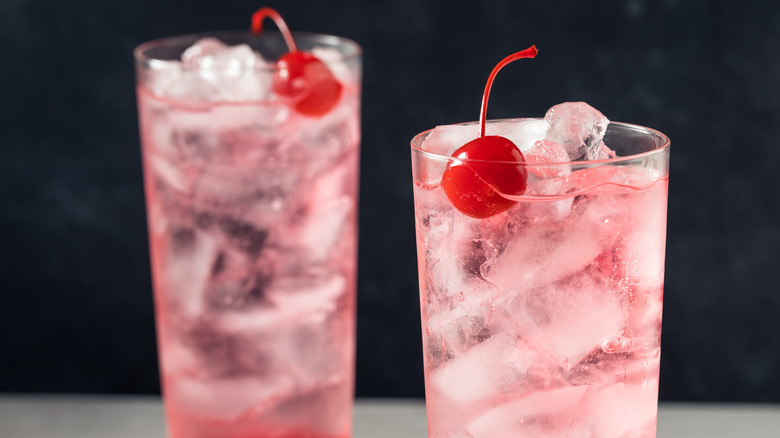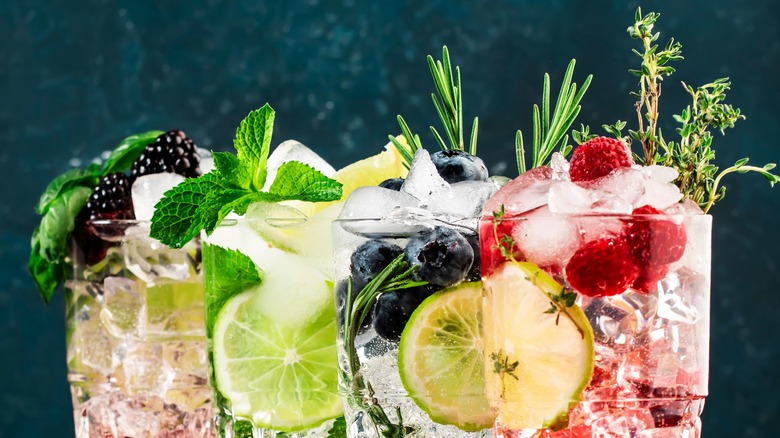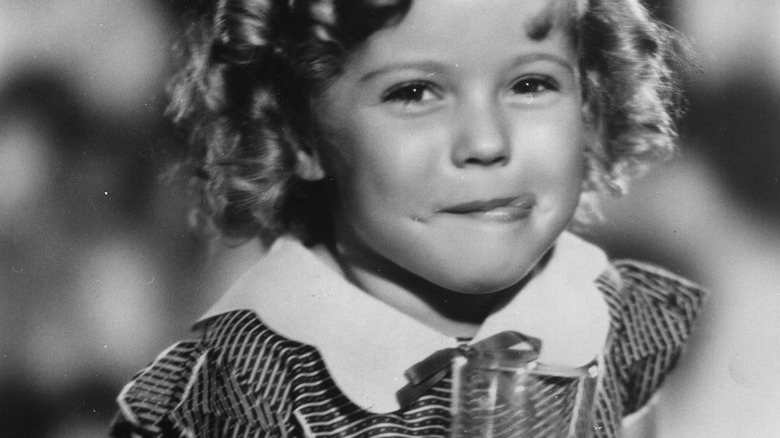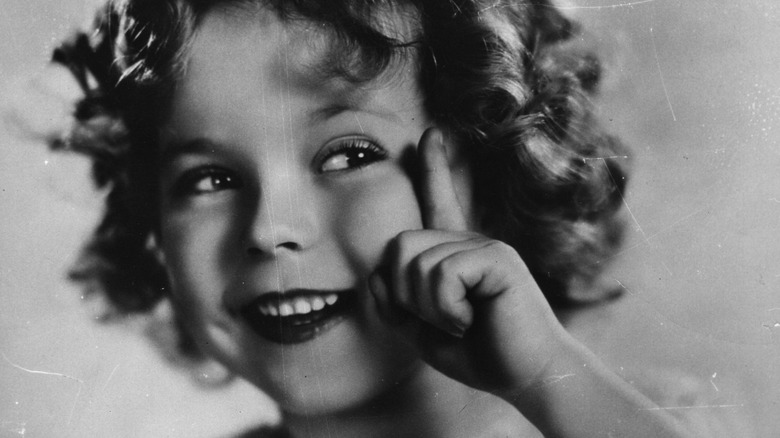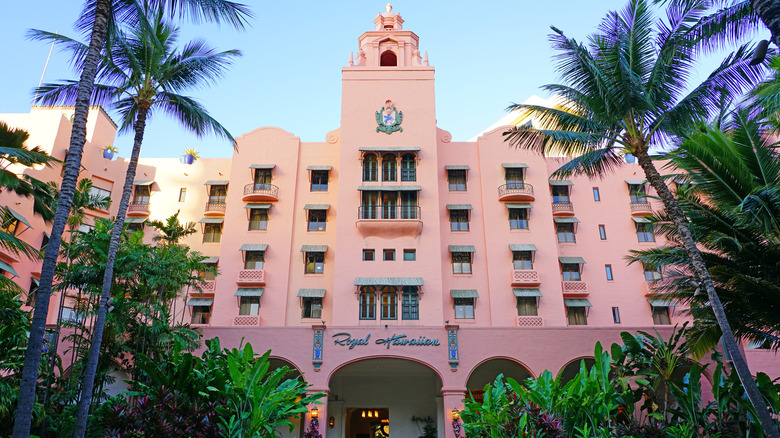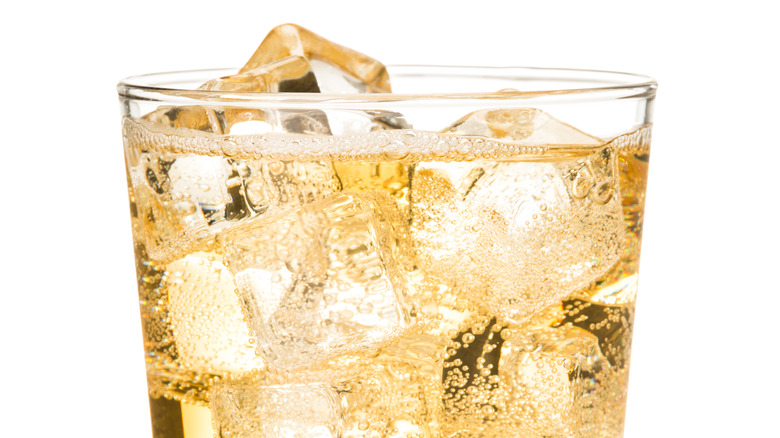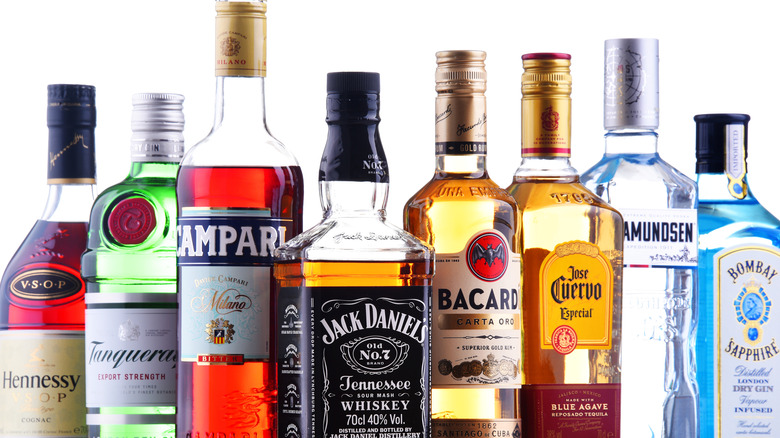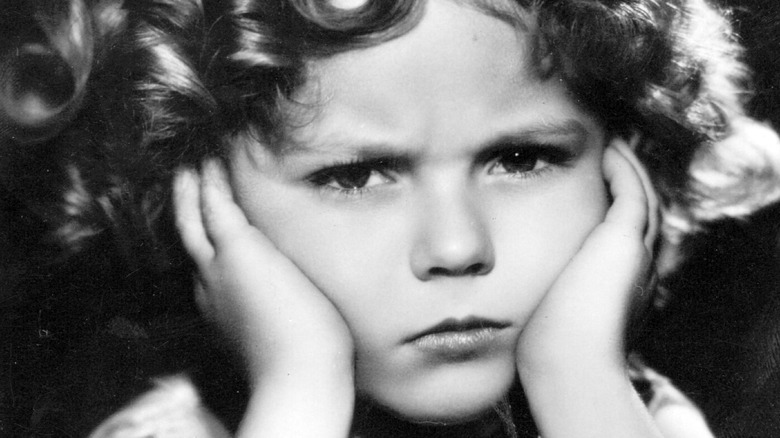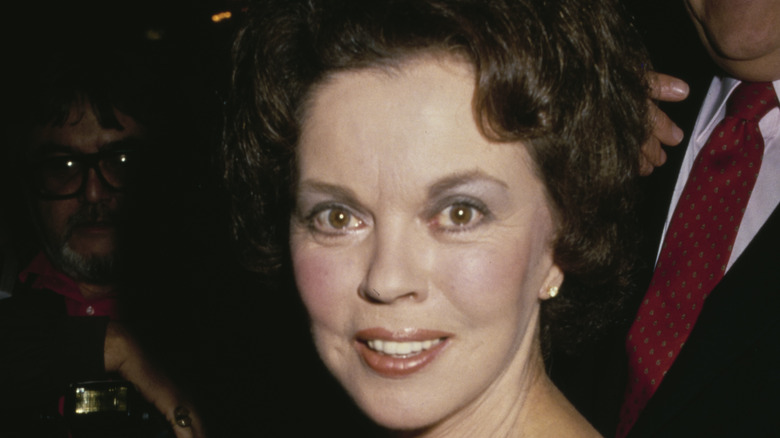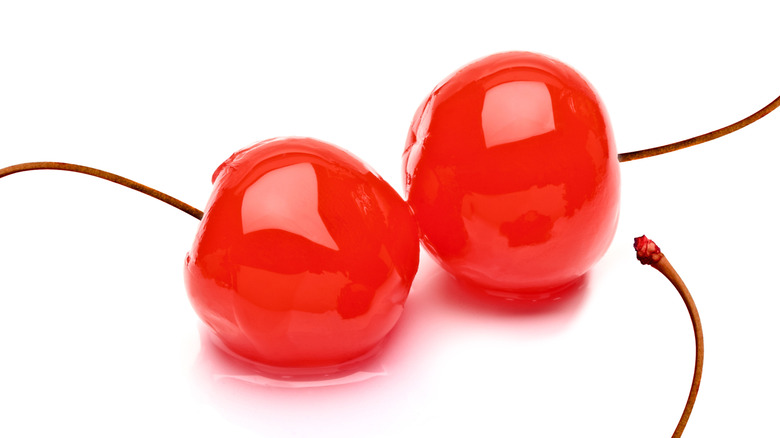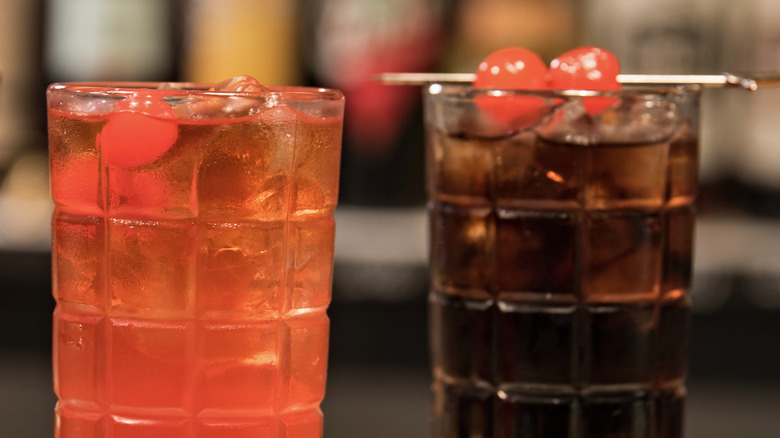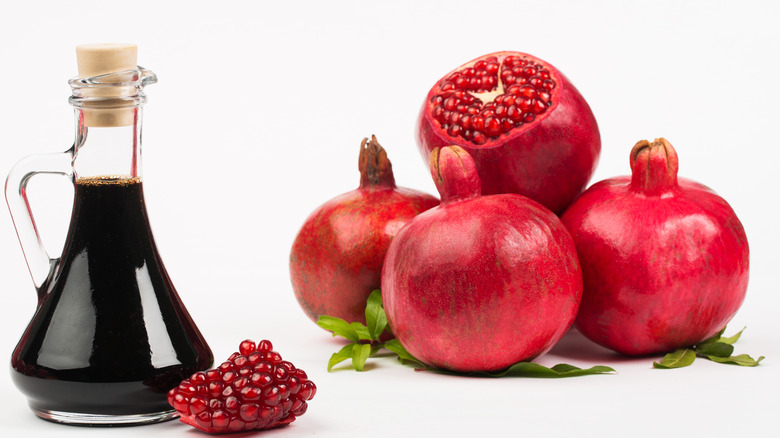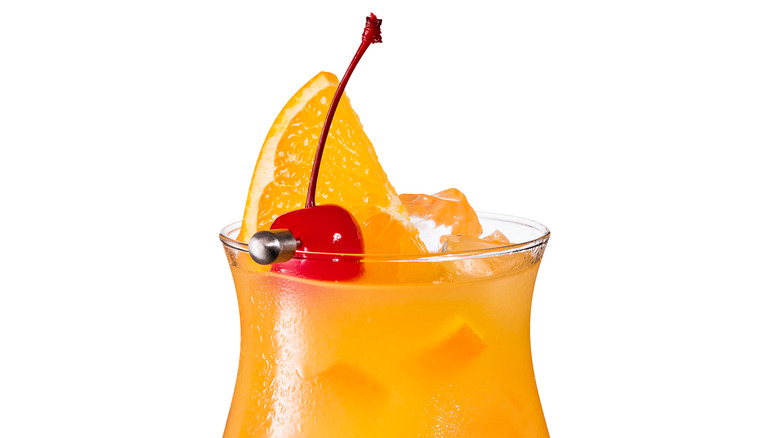The Untold Truth Of The Shirley Temple
Unless your parents were strictly the "no soda" type and you never strayed from their orders even when they weren't around, you've almost certainly had at least one Shirley Temple drink in your life, and you've likely had tons. It's every child's favorite special occasion beverage, and plenty of adults love them too. Part of the charming beverage's universal appeal is its sweet simplicity (emphasis on the sweet, sweet sugary goodness that sends so many people's tastebuds into rapturous appreciation), but there's more to the drink than meets the eye. Or tongue.
From the deceptively simple recipe that scores of people still manage to get wrong to the myths surrounding its origin, the Shirley Temple may share a name with one of the world's biggest-ever child stars, but there isn't much else that's very clear about this delightful drink. Beneath the fizzy surface of this red (or should it be pink?) mocktail, there are plenty of misconceptions swirling. Here is the untold truth of the Shirley Temple.
It's credited as the original mocktail
Per NPR, the Shirley Temple drink is similarly considered the world's first mocktail. Of course, non-alcoholic concoctions have certainly been around since long before the 20th century, but this special blend put faux-fanciness on the cultural map for those who couldn't, or didn't want to, drink alcohol.
Today, mocktail menus are as fashionable as cocktail menus, and some recipes are even more intricate and alluring than their intoxicating counterparts. Thanks to the level of knowledge and skill that goes into sophisticated, modern mocktail programs, you'll generally find that the price of a serious mocktail is competitive with a cocktail, too. You can even drink these fancy booze-free beverages at no-alcohol bars.
The Shirley Temple itself may not be a particularly difficult drink to mix, but it has certainly spawned an entire industry of specialty libations that, though alcohol-free, still contain the fanciest of ingredients and come from the clever minds of the same mixologists shaking and stirring showstopping cocktails.
Legend says it was developed for the child actress at Chasen's
It's not entirely certain where the Shirley Temple mocktail was invented, but one Hollywood restaurant, Chasen's — a legend in its own right — finds its way into more origin stories and interviews than any other, and is often credited as the birthplace of the Shirley Temple. The wood-paneled restaurant was packed with star-studded leather booths dressed in a red as beguiling as the most generously grenadined Shirley Temple and is purported to have hosted the young actress for dinner in the 1930s.
Whether it was the restaurant staff who wanted to serve her something special or the actress herself who wished for something as sophisticated as the drinks her parents were enjoying is a detail that changes with each telling, but this is the storied beginning of the lasting legend. And, like most origin stories (especially those surrounding mixed drinks, alcoholic or otherwise), there's virtually no evidence to back this one up, so it can't truly advance past the dubious rank of "legend." Either way, it's a nice story of a charming child actress visiting an Old Hollywood staple and giving rise to a drink that would endure for nearly a century (so far).
Shirley Temple herself said it wasn't actually created in her presence
As charming as the Chasen's tale is, there was one reasonably authoritative source on the subject who said it wasn't true, and that was Shirley Temple, herself. Not only did Shirley Temple tell NPR's Scott Simon that the drink was, in fact, first created at the Brown Derby restaurant in Hollywood, but she claimed she was not present at the time. Quite to the point, Temple claimed, "I had nothing to do with it," during the interview.
Of course, stars aren't always the most reliable narrators of their own stories and this version of the creation myth is equally without evidence, but there wouldn't have been much value in the actress falsely denying her association with the beloved beverage, so it's reasonable to assume she truly wasn't present when the first Shirley Temple was served. Still, her assumption that the drink was created at the Hollywood Brown Derby should be taken as lightly as the Chasen's claim, especially since, as she herself said, she wasn't even there when it happened.
Despite Temple's statement, other venues claim to have invented it (for her)
It's unlikely that the birthplace of a mocktail is the most pressing issue on your mind and keeping you up at night, but it's pretty serious business for some. With claims rolling in from the legendary likes of Chasen's and the Brown Derby, and with the star herself giving the testimony that it never involved her at all, it's tough to discern much in the way of fact. Institutions like The Hollywood Museum can certainly weigh in on the issue, however. In an interview with US Weekly, the museum's founder said that either restaurant made sense as the possible origin, as they were both very popular with the industry crowd at the time. She also admitted they would both have been anxious to claim the title, so we can't really be sure which (if either) was authentic.
Further complicating the question, there's a hotel in Hawaii that claims to have invented the Shirley Temple, once again parroting the personal detail that it was made to serve directly to the young star. The Royal Hawaiian hotel in Honolulu is a storied property that did actually host Shirley Temple in 1935 but the persistent claim that they invented the drink for her tends to hold less street cred than the Hollywood restaurants saying the same. Still, let's not forget that Temple said nobody invented the drink for her, regardless of where it was born.
It's traditionally made with ginger ale, not Sprite
You may associate the Shirley Temple mocktail with a lemon-lime soda like Sprite or 7UP, but the original recipe included neither, and this isn't just a matter of branding. As a simple matter of chronology, Sprite was invented in 1961, around 25 years after the Shirley Temple, and 7UP did exist in some form in the 1930s but an authentic Shirley Temple drink includes no citrus flavor at all. In its pure, original form, the ever-popular mocktail is a simple mix of just three ingredients: ginger ale, grenadine, and a maraschino cherry garnish.
Today, lemon-lime sodas often replace the original ginger ale of a Shirley Temple, but there are less saccharine ways of adding some citrusy pep to the drink. The Food Network suggests muddling fresh lime in a glass before adding the classic ingredients, and there's no reason you couldn't do the same with some lemon slices. You could even just add a few dashes of fresh juice from each before stirring. But if you want to sip the original Shirley Temple, you'll need to forego that citrus completely.
There are alcoholic versions
First of all, no one should be embarrassed to order a Shirley Temple at any age — we all loved them once and many of us still do, so live your best life and drink what you want to drink. If, however, you want to sample some of that childhood delight and add a little 21+ fun to the mix, there are several well-known alcoholic versions of the beverage.
The Dirty Shirley is a boozy riff on the lemon-lime adaptation of the mocktail, adding vodka to citrus soda and grenadine before topping with maraschino cherries, of course. This one works just as well with ginger ale, too, so don't be afraid to stick to the original recipe (plus vodka) if you're a purist. If vodka isn't your favorite spirit, there's still hope for you: Some variations of the Dirty Shirley recipe opt for white rum instead, and you can even sub dark rum for a Dirty Shirley Black (her married name). Other variations sub ginger beer for the ginger ale as well.
Shirley Temple hated the drink
The Shirley Temple was a favorite childhood drink for many of us, but it appears that this wasn't the case for the mocktail's namesake. As reported by Daveland, Shirley Temple gave her true opinion of the beverage in a 1986 NPR interview, and it was far from a rave review. "All over the world, I am served that. People think it's funny. I hate them. Too sweet," she said.
By this time, Shirley Temple (now Shirley Temple Black), was nearing the age of 60 and recalling a lifetime of being served the same drink wherever she went, so it's certainly possible that her opinion of the drink had become tainted by decades of flavor fatigue. Whether she enjoyed her eponymous beverage as a child, when it was new, will likely remain a mystery as there doesn't appear to be any record of her opinion at the time, but it's clear she was completely over it by the time she finally did speak out in the 1980s.
The actress fought to keep soft drink brands from using her name
Brands lining up for celebrity endorsements and licensing deals for promotion is nothing new, and Shirley Temple was certainly not immune from these requests. In the 1980s, the actress reported that she had licensed her name for an estimated 140 products through the years, but she wasn't just a money-hungry sell-out with no standards. While she also recalled denying her name to a potato chip manufacturer, she most famously fought to keep her name away from any products marketing a Shirley Temple mocktail, especially to children.
In 1988, Shirley Temple sued two different soft drink manufacturers for using variations of her name on pre-mixed Shirley Temple drinks. Aside from being a fierce protector of her name who vowed to "fight it like a tigress" when it was used without permission, she was especially incensed by the thought of this particular product bearing her moniker because she was against the idea of any type of cocktail for children. She even denied a best friend's husband the opportunity to market a Shirley Temple beverage.
The number of cherries used is a personal matter, especially to kids
Surprised to realize that Shirley Temples were as popular as ever with children in 2020, some 85 years and several generations after the drink was invented, The Wall Street Journal writer Lettie Teague set out to uncover exactly what about the recipe still held such appeal for modern mini-humans. Through a series of interviews, Teague discovered that it wasn't the soda or even the syrupy sweet grenadine that drew kids in, but the drink's humble garnish, the maraschino cherry. What differed from child to child, however, was the quantity.
Informal interviews with a small number of children across the United States revealed that the diminutive Shirley Temple lovers each had very specific ideas of how to make the drink, including the exact number of cherries that should top the glass. While some kids preferred a reasonable two or three cherries, the sample included respondents demanding five, six, and even seven cherries in the ideal Shirley Temple, each for personal reasons ranging from tradition to "I like the number." Whatever the reason, the cherry comes out on top as the most beloved ingredient in the Shirley Temple, and quantity counts.
There's a 'boy name' counterpart
While kids across the gender spectrum can enjoy the taste of a Shirley Temple, there is also a "boy's" version of the drink that isn't pink and is named after a male celebrity. The Roy Rogers mocktail, named after the famous singing cowboy, appeals to young boys looking for a special drink of their own (via 10Best).
While the Shirley Temple traditionally adds grenadine to ginger ale (or lemon-lime soda), the Roy Rogers combines grenadine with cola before garnishing with the all-important maraschino cherry of Shirley Temple fame. The only physical difference between the drinks is subbing one soft drink for another, but the change in names widens the appeal to a much larger child audience. Both drinks continue to exist today and have their unique flavor appeals that draw in children and adults of every kind.
It's not a Shirley Temple without real grenadine
Admit it: You've tried to make a Shirley Temple at home and didn't have grenadine on hand, so you just poured in some juice from the jar of maraschino cherries (it's okay, we won't even force you to admit the drink was for you — you can pretend it was for a kid). Using syrupy maraschino juice may seem like a reasonable substitution in an hour of need because grenadine is just cherry-flavored syrup, right? Wrong.
True grenadine is not actually made from cherries at all, but instead comes from pomegranate. It's an essential ingredient of the Shirley Temple mocktail. While we don't blame you for being confused since there's a cherry floating in the red-tinted drink, if you're just adding cherry-flavored products to your ginger ale or lemon-lime soda, you're making a cherry soda, not a Shirley Temple. The same holds for a Roy Rogers, which would just become a cherry cola in this case.
Canadians add orange juice to the recipe
One of the great joys of traveling is discovering the ways that recipes change around the world, or even across different areas of your own country, and this absolutely includes beverages. Among the many culinary differences between Canada and the United States, the simple Shirley Temple recipe presents one of the biggest surprises.
As Americans have adapted the original Shirley Temple recipe to include lemon-lime sodas, Canadians have gone a step further in the citrus sphere, adding orange juice to their standard recipe (via Canadian Living). The result is a mocktail that visually resembles more of a tequila sunrise than what Americans would consider to be a Shirley Temple. We confirmed this regional quirk with multiple sources, including the What's Different in Canada blog and this recipe from a food writer in Calgary, Canada. How the orange found its way so prominently into the Canadian Shirley Temple is unclear, but it's not just an option there; it's a requirement.
